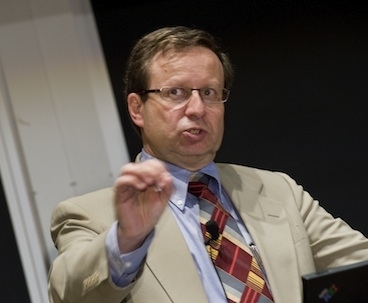As a theoretical physicist by training, Steven E. Koonin PhD ’75 might have been expected to focus his talk at MIT on Wednesday, Sept. 22, on the scientific and technological aspects of energy policy. But he made it clear right away that business and economics are the real keys to progress in the energy frontier.
It’s the economics that are “absolutely essential if the technologies are going to have an impact,” he said at the outset of the annual Hoyt C. Hottel lecture sponsored by the MIT Department of Chemical Engineering, before a packed hall in the Stata Center.
“There is an urgency” about dealing with the problems of energy just from a national-security perspective, even apart from the dangers of climate change, he said, pointing out that the United States currently sends about $1 billion a day to other nations to feed our petroleum appetite. That makes us “subject to the actions and fates of centers distant from us,” he said.
But the decisions about building new power plants or investing in major new energy infrastructure are more complex than most people realize, he said. Having spent five years working for BP before assuming his present government post (as the nation’s second under secretary for science at the Department of Energy), he says he learned a great deal about that complexity. “I can tell you, it was an eye opener,” he said.
“If you want to change the energy industry, you should get to know it,” he said. “The energy-supply business is not simple, and the people in it are not troglodytes.”
As someone with a long academic background — he spent years as a professor at Caltech and then almost a decade as its provost — he postulated the issue in the form of a simple syllogism:
So to spur innovation and the deployment of new forms of energy, regulation and financial incentives are key, he said. He cited as an example the way installations of new wind turbines in the United States have risen and fallen in lockstep with the back-and-forth passage and repeal of production tax credits for the industry.
But technological innovation still plays an important role, he said. While much of the innovation in energy has already shifted overseas, he said, the U.S. continues to dominate in at least one area that could provide a significant advantage in the development of new energy options: Sophisticated computer simulations, an area of technology initially developed under the DoE to foster research on nuclear weapons without the need for actual nuclear-bomb tests. He noted that such simulations, with DoE’s help, made it possible for Goodyear to develop an innovative new line of tires in a fraction of the time such development would normally take — an advance that may have saved the company from the brink of bankruptcy.
“This is a uniquely U.S. capability, and it gives us a competitive advantage,” he said.
It’s the economics that are “absolutely essential if the technologies are going to have an impact,” he said at the outset of the annual Hoyt C. Hottel lecture sponsored by the MIT Department of Chemical Engineering, before a packed hall in the Stata Center.
“There is an urgency” about dealing with the problems of energy just from a national-security perspective, even apart from the dangers of climate change, he said, pointing out that the United States currently sends about $1 billion a day to other nations to feed our petroleum appetite. That makes us “subject to the actions and fates of centers distant from us,” he said.
But the decisions about building new power plants or investing in major new energy infrastructure are more complex than most people realize, he said. Having spent five years working for BP before assuming his present government post (as the nation’s second under secretary for science at the Department of Energy), he says he learned a great deal about that complexity. “I can tell you, it was an eye opener,” he said.
“If you want to change the energy industry, you should get to know it,” he said. “The energy-supply business is not simple, and the people in it are not troglodytes.”
As someone with a long academic background — he spent years as a professor at Caltech and then almost a decade as its provost — he postulated the issue in the form of a simple syllogism:
- Almost the entire energy industry, with only a few exceptions, is in the hands of private industry;
- Industry’s primary goal is a legal and predictable profit;
- Therefore, innovation in the energy supply will only reach a significant scale when it is profitable or mandated.
So to spur innovation and the deployment of new forms of energy, regulation and financial incentives are key, he said. He cited as an example the way installations of new wind turbines in the United States have risen and fallen in lockstep with the back-and-forth passage and repeal of production tax credits for the industry.
But technological innovation still plays an important role, he said. While much of the innovation in energy has already shifted overseas, he said, the U.S. continues to dominate in at least one area that could provide a significant advantage in the development of new energy options: Sophisticated computer simulations, an area of technology initially developed under the DoE to foster research on nuclear weapons without the need for actual nuclear-bomb tests. He noted that such simulations, with DoE’s help, made it possible for Goodyear to develop an innovative new line of tires in a fraction of the time such development would normally take — an advance that may have saved the company from the brink of bankruptcy.
“This is a uniquely U.S. capability, and it gives us a competitive advantage,” he said.






